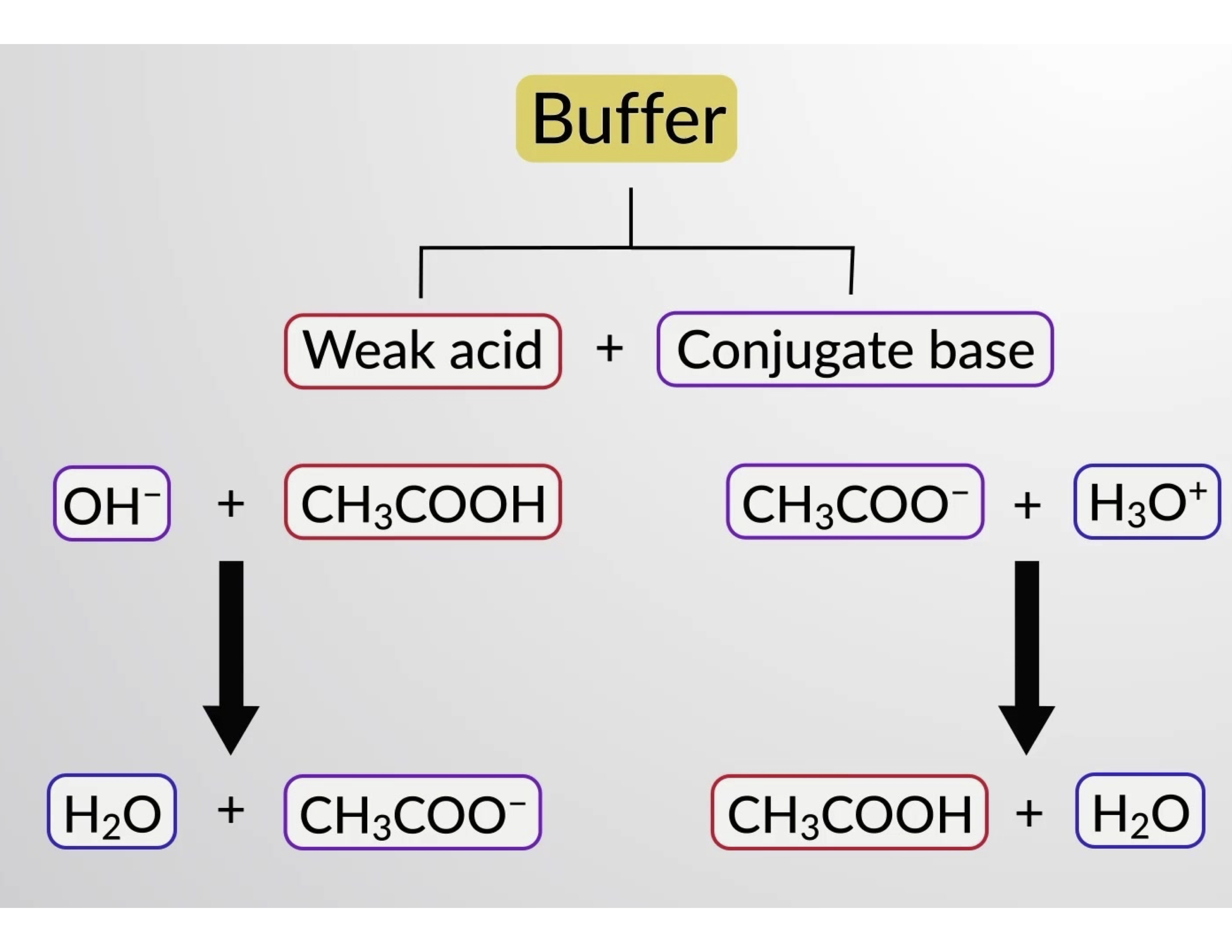A solution containing appreciable amounts of a weak conjugate acid-base pair is called a buffer solution, or a buffer. Buffer solutions resist a change in pH when small amounts of a strong acid or a strong base are added. A solution of acetic acid and sodium acetate is an example of a buffer that consists of a weak acid and its salt: CH3COOH (aq) + CH3COONa (aq). An example of a buffer that consists of a weak base and its salt is a solution of ammonia and ammonium chloride: NH3 (aq) + NH4Cl (aq).
How Buffers Work
To illustrate the function of a buffer solution, consider a mixture of roughly equal amounts of acetic acid and sodium acetate. The presence of a weak conjugate acid-base pair in the solution imparts the ability to neutralize modest amounts of added strong acid or base. For example, adding a strong base to this solution will neutralize hydronium ion and shift the acetic acid ionization equilibrium to the right, partially restoring the decreased H3O+ concentration:

Likewise, adding a strong acid to this buffer solution will neutralize acetate ion, shifting the above ionization equilibrium right and returning [H3O+] to near its original value. Figure 1 provides a graphical illustration of the changes to the buffer solution when strong acid and base are added. The buffering action of the solution is essentially a result of the added strong acid and base being converted to the weak acid and base that make up the buffer's conjugate pair. The weaker acid and base undergo only slight ionization, as compared to the complete ionization of the strong acid and base. The solution pH, therefore, changes much less drastically than it would in an unbuffered solution.

Figure 1. Buffering action in a mixture of acetic acid and acetate salt.
This text is adapted from Openstax, Chemistry 2e, Section 14.6: Buffers.
Aus Kapitel 16:

Now Playing
16.2 : Buffers
Säure-Base- und Löslichkeitsgleichgewicht
162.9K Ansichten

16.1 : Gemeinsamer Ioneneffekt
Säure-Base- und Löslichkeitsgleichgewicht
40.6K Ansichten

16.3 : Henderson-Hasselbalch-Gleichung
Säure-Base- und Löslichkeitsgleichgewicht
67.6K Ansichten

16.4 : Berechnung von pH-Änderungen in einer Pufferlösung
Säure-Base- und Löslichkeitsgleichgewicht
52.2K Ansichten

16.5 : Wirksamkeit des Puffers
Säure-Base- und Löslichkeitsgleichgewicht
48.1K Ansichten

16.6 : Titrationsberechnungen: Starke Säure - Starke Base
Säure-Base- und Löslichkeitsgleichgewicht
28.7K Ansichten

16.7 : Titrationsberechnungen: Schwache Säure - Starke Base
Säure-Base- und Löslichkeitsgleichgewicht
43.3K Ansichten

16.8 : Indikatoren
Säure-Base- und Löslichkeitsgleichgewicht
47.5K Ansichten

16.9 : Titration einer polyprotischen Säure
Säure-Base- und Löslichkeitsgleichgewicht
95.4K Ansichten

16.10 : Löslichkeits-Gleichgewichte
Säure-Base- und Löslichkeitsgleichgewicht
51.1K Ansichten

16.11 : Faktoren, die die Löslichkeit beeinflussen
Säure-Base- und Löslichkeitsgleichgewicht
32.8K Ansichten

16.12 : Bildung komplexer Ionen
Säure-Base- und Löslichkeitsgleichgewicht
22.9K Ansichten

16.13 : Ausfällung von Ionen
Säure-Base- und Löslichkeitsgleichgewicht
27.3K Ansichten

16.14 : Qualitative Analyse
Säure-Base- und Löslichkeitsgleichgewicht
19.8K Ansichten

16.15 : Säure-Base-Titrationskurven
Säure-Base- und Löslichkeitsgleichgewicht
125.4K Ansichten
Copyright © 2025 MyJoVE Corporation. Alle Rechte vorbehalten